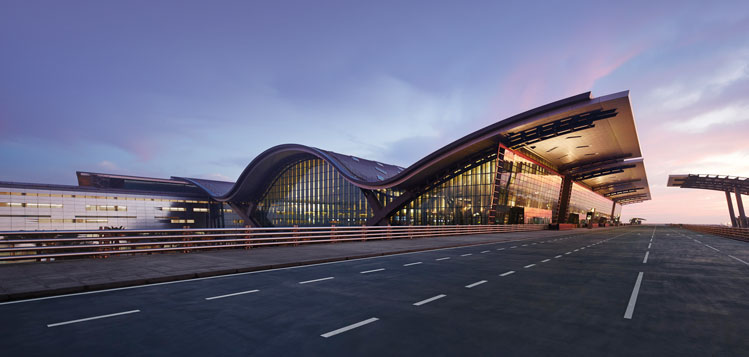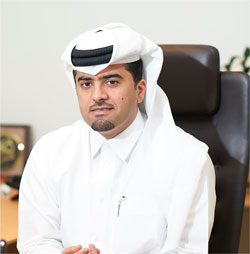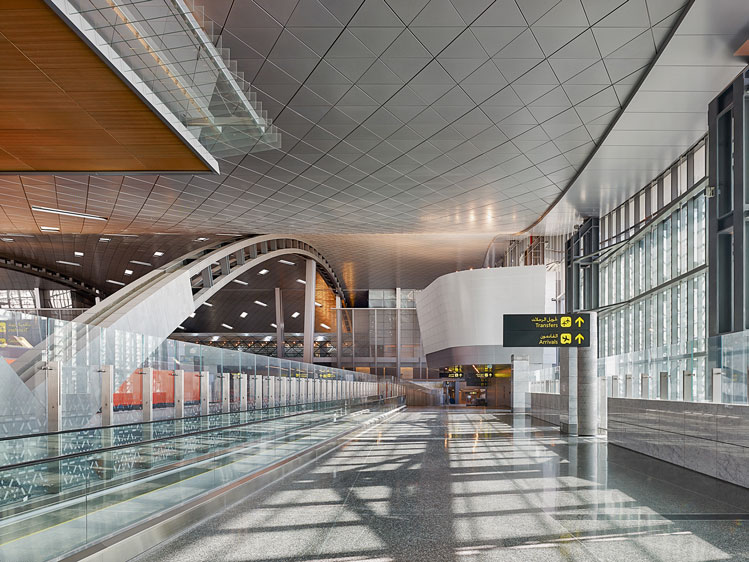As Qatar is gearing up to receive thousands of visitors during the FIFA World Cup in 2022, boosting airport capacity is essential. Hamad International Airport’s Phase 2 expansion plan is underway, with the main priority to reduce waiting times at all airport touch points using cutting-edge technology and automation. Engr. Badr Al-Meer, Chief Operating Officer, Hamad International Airport, outlined developments to Marta Dimitrova.
An airport’s healthy development depends on multiple factors, all contributing to steady and sustainable growth. In the case of Hamad International Airport (HIA), these factors include a clear vision, a well thought-out digital transformation plan, new alliances, strategic partnerships and a highly passenger-centric approach. Today, HIA is making the most out of changing travel trends and is benefiting from a promising economic forecast for both the region and Qatar, while also preparing to host the FIFA World Cup in 2022.
In June, the airport announced strong year-on-year growth with 19 million passengers and 980,000 tonnes of cargo handled from January to June 2017, making it its busiest six-month period yet.

“First and foremost, our growth stems from a clear vision and a sound investment strategy,” explains Engr. Badr Al-Meer, Chief Operating Officer, Hamad International Airport. “Since its opening in 2014, HIA has stated its ambition to become a world-leading hub and our efforts across the board are directed towards this goal.”
Secondly, HIA’s digital transformation is an integral part of the airport’s success. In 2016, HIA launched its ‘Smart Airport’ vision, which lays out the airport’s digital transformation plan, under the patronage of HE the Prime Minister and Minister of Interior Sheikh Abdullah bin Nasser bin Khalifa Al-Thani. The airport currently offers self-service capability for check-in, bag drop and border control checks, as well as the HIA mobile application, which supplements information desks and customer information points. Al-Meer adds that “the next step will focus on exploring the use of facial recognition, biometrics, Artificial Intelligence, robotics, and augmented and virtual reality.”
“The airport of the future”
Recently, to improve its digital transformation and passenger experience, while increasing operational efficiency, HIA signed strategic partnerships with both global IT provider SITA and global information and communications technology (ICT) solutions provider Huawei.

Engr. Badr Al-Meer, Chief Operating Officer, Hamad International Airport: “Since its opening in 2014, HIA has stated its ambition to become a world-leading hub and our efforts across the board are directed towards this goal.”
HIA’s agreement with SITA provides a framework to trial and enhance innovative passenger processing solutions, in line with HIA’s ‘Smart Airport’ vision. Passengers would be required to register their face at check-in, self-baggage drop, immigration and then finally at the automated boarding gate; hence offering a seamless journey. Additionally, SITA will also be supplying its next generation common use check-in kiosks, with bag tag printing capability.
While the partnership with SITA focuses on opportunities for transforming the passenger experience, HIA’s cooperation with Huawei is primarily aimed at evaluating ways of transforming the technology and communications infrastructure of the airport, which HIA believes to be “the foundation for technology-enabled business transformation”. “Given HIA’s ambition to become the airport of the future with a very user-centric approach, we endeavour to partner with industry leaders,” says Al-Meer.
At the core of HIA’s business is achieving “operational excellence” offering passengers “five-star services and hassle-free travel experience”, and Al-Meer believes that extensive research is of paramount importance. “HIA’s strengths reside in its deep understanding of our passengers, which is the result of our solid research programme aimed at studying travel behaviours, travellers’ needs and their expectations, from the smallest to the essential ones. It allows us to deliver on our commitment to offer a stress-free experience and a five-star service to all our passengers at all times.
“We can achieve this thanks to the use of cutting-edge technology at check-in, security scanners and fully automated baggage systems with the capacity to handle more than 19,000 bags every hour,” continued Al-Meer. “Cutting-edge technology is integrated at every touch point at the airport and across all our facilities. The airport was designed to ensure full passenger functionality and we keep improving our services to deliver the best passenger service.”
Moreover, HIA’s growth is also due to the increase in frequency of several of its patron airlines’ weekly flights from HIA, as well as new airlines joining the network such as Indigo and US-Bangla, which started operations in early October, and SalamAir in November.
ACI Airport Carbon Accreditation Level 3 Optimisation
Environmental development is one of the four central pillars of Qatar’s National Strategy 2030. HIA’s environmental strategy is, therefore, fully aligned with the vision of its nation, as well as with international standards aimed at building a sustainable air transport industry by minimising environmental impacts while supporting economic and social advancement.
After expansion, the airport will handle more than 50 million passengers per year, whereas the completion of the second cargo terminal will enable the handling of 2.8 million tonnes of cargo per year. “Global environmental standards are embedded in our expansion plan as our target is to improve carbon efficiency per passenger by 30% by 2030 against a 2015 baseline,” Al-Meer explains.
HIA is strongly committed to minimising its consumption of natural resources, controlling emissions and managing waste carefully. “Achieving Level 3 of ACI’s Airport Carbon Accreditation programme is recognition of this commitment and we continue to build on it,” Al-Meer adds. “In terms of energy efficiency, our latest modifications to heating, lighting, ventilation and air-conditioning systems across the airport’s campus have been identified to save an estimated 4,462,600 kWh of energy per year. With rapid growth and increased passenger traffic, we also closely monitor the airport’s CO2 emissions. HIA improved the average efficiency of CO2 per passenger by 4% and per aircraft movement by 1.2% during 2015 compared to 2014, year of the opening.”
The construction process of the airport and its design are the perfect illustration of HIA’s sustainable mind-set. In order to conserve energy needed for cooling, the walls of the passenger terminal are coated with solar reflective material and the roof is insulated, and designed with overhang shading. The airport central district cooling system is 15-20% more efficient than individual cooling units. Design features, which include motion-activated escalators and moving walkways, further reduce energy demand.
Hamad International Airport factbox
2016: 37.3 million passengers
2016 passenger traffic growth: 20.5%
2017 passenger traffic growth (1H): 8%
Key airline customers: Qatar Airways, British Airways, Turkish Airlines, Royal Air Maroc
New airline customers in 2017: Indigo Airlines, Regent Airways, US-Bangla Airlines, SalamAir, Jazeera Airways, Turkish Airlines (Cargo), Royal Jordanian (Cargo)
Number of routes: 150
Top 5 destinations: London Heathrow, Kuwait, Colombo, Bangkok, Muscat
Young, yet ambitious, HIA is growing fast, however managing growth comes with many challenges. Tackling those challenges will be HIA’s main priority in the coming years.
“Qatar Airways’ growing network – now connecting Doha directly to 14 new destinations – combined with HIA’s latest record of passenger traffic, aircraft movements, new foreign airlines joining our network, baggage handling, as well as the amount of cargo handled, are leading us to focus our efforts and investment on increasing the airport’s capacity, our very first challenge,” Al-Meer concludes.

The construction process of the airport and its design are the perfect illustration of HIA’s sustainable mind-set. In order to conserve energy needed for cooling, the walls of the passenger terminal are coated with solar reflective material and the roof is insulated, and designed with overhang shading.







